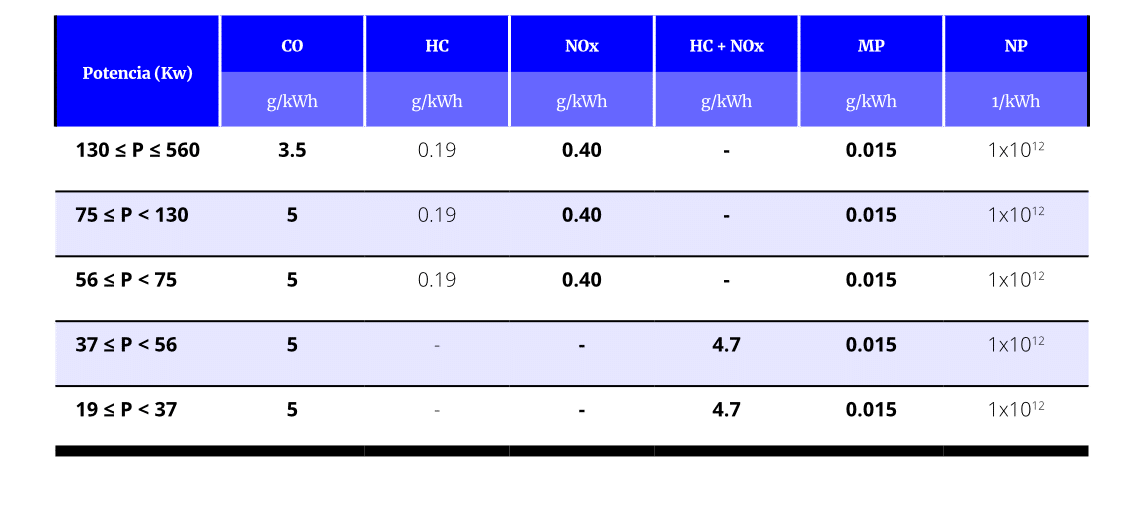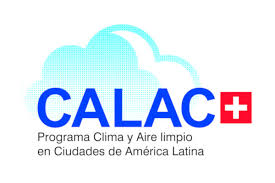CHILE (en)

/1/
Definitions of
non-road mobile
machinery
On 21 October 2021, the emission standard for mobile machinery, which applies to non-road mobile machinery, was published in the official gazette, in which all imported machinery with a power between 19 and 560 kW will be required to meet the Stage IV or V regulatory standard 24 months after publication of the standard, with the exception of tractors, which will have a period of 30 months.
The Decree defines mobile machinery and engine types or engine families as follows:
Mobile machinery: machinery not intended for the carriage of passengers or goods by road, capable of travelling on the ground, with or without a road, and powered by compression-ignition internal combustion engines with a net installed power of 19 kW or above but not exceeding 560 kW. Excluded are engines intended for the propulsion of railcars, locomotives or other railway or rail-borne equipment, ships, aircraft and recreational vehicles.
Engine type or engine family: manufacturer’s grouping of engine types which, by design, have similar exhaust emission characteristics and comply with the applicable emission limit values.

/2/
Main regulatory
instruments for NRMM
emissions reduction
Tabla 1
Regulatory framework and identification of tools to reduce MMNC emissions – Chile.


/3/
Emission standards
for air pollutants
The Supreme Decree N°39/2020 of the Ministry of Environment establishes the emission standard for mobile machinery which will come into force 24 months after the publication of the standard, with the exception of tractors which have a period of 30 months. The regulation sets emission limits equivalent to the European Stage IV or V standard as indicated in Tables 2 and 3 respectively.
Tabla 2
Maximum emission limits from the exhaust system

Fuente: Ministerio de Medio Ambiente, 2021.
Tabla 3
Maximum emission limits from the exhaust system.

Fuente: Ministerio de Medio Ambiente, 2021.
The aforementioned regulation indicates that the Superintendencia del Medio Ambiente (SMA) (Superintendency of the Environment) is in charge of establishing protocols and procedures to determine compliance with the regulation. On the other hand, it is mentioned that:
“The manufacturers or their legal representatives in Chile, distributors or importers, of mobile machinery affected by the emission limits required in Tables 2 or 3, shall submit a certificate to the Superintendencia del Medio Ambiente, which shall verify, the emissions compliance of the type or engine family of the mobile machinery, prior to its importation, according to the procedures established by Regulation (EU) 2016/1628 of the European Parliament and of the Council, or by the United States Code of Federal Regulations (CFR), title 40, part 1039, as applicable.”

/4/
Import requirements
and type-approval
processes
All mobile machinery entering Chilean territory 24 months after the entry into force of the regulation must comply with the emission standards reported in Decree 39/2020 of the MMA, with the exception of tractors which have a period of 36 months. Likewise, importers or distributors, manufacturers or their legal representatives in Chile must submit a certificate of compliance to the SMA, of the emission standards of the engine type or family of the mobile machinery, prior to its importation.
The National Customs Service will have to report monthly to the SMA on the machinery imported in the month prior to the one being reported, once the rule comes into force. In addition, after 6 months from the entry into force of the rule, they will have to issue an official notice giving instructions regarding the importation of mobile machinery.

/5/
Labelling
processes
Regading the use of labelling on machinery, this aspect has not yet been regulated.

/6/
Regulation on machinery
useful life, repowering, overhaul and
scrapping practices
For Chile, no maximum fleet age requirements for operation were identified.

/7/
Operational and road
circulation requirements
7.1 General road circulation requirements
It should be clarified that the road circulation requirements defined in the regulations described below apply to all types of vehicles and their application on NRMM is not specified.
Citing the Decree with Force of Law 1 Fixing the Consolidated, Coordinated and Systematised Text of the Traffic Law (2014), in numeral 35, the definition of padrón or vehicle registration certificate is as follows:
Registration or registration certificate: “document issued by the authority, intended to identify the vehicle and its owner so that it can transit on public roads”.
Likewise, Title 1 of the aforementioned decree “On drivers and licences” in its articles 5 and 6, states:
Article 5: No person may drive a motorised or animal-drawn vehicle, without a licence issued by the Director of the Municipal Traffic and Public Transport Department of a Municipality authorised for this purpose; or a provisional permit which the Courts may grant only to drivers who have their licence withheld due to pending proceedings; or a court summons, issued by the officials referred to in Article 4 in replacement of the aforementioned licence or permit; or a valid international licence or permit to drive motor vehicles, granted under international treaties or agreements to which Chile is a party.
Article 6: Drivers of motorised or animal-drawn vehicles, with the exception of the previous article, must carry their licence, permit or citation slip with them and, when required by the competent authority, prove their identity and hand over the documents that entitle them to drive.
On the other hand, §2 “On the single licence plate, the registration certificate and the certificate of compulsory motor vehicle accident insurance” states in Article 51 (2014):
Article 51: Motor vehicles may not be driven without a single number plate, a vehicle registration certificate issued by the municipality and a compulsory motor vehicle accident insurance certificate (Subsection 1).
Trailers and semi-trailers that must be registered in the Special Register of Trailers and Semi-trailers must have a unique number plate, without which they are not authorised to transit (Subsection 2).
The unique number plate must be obtained at the Office of the Civil Registry and Identification Service where the registration is requested (Subsection 3).
The compulsory motor vehicle accident insurance certificate must always be carried in the vehicle and be valid (Subsection 4).
7.2 Environmental operating requirements for NRMM
In terms of environmental requirements for the operation of machinery, the emission standard for mobile machinery must be complied with by October 2023, with the exception of tractors, which will have a 36-month deadline.
On the other hand, for the Metropolitan Region of Santiago de Chile, it was identified that according to Article 18 of Decree 31 (Ministry of Environment of Chile, 2017), the Ministries of Public Works, Housing and Urbanism, and Health when executing construction works must use closed particulate filters for their own and third-party machinery.

/8/
Procedures for NRMM
control and inspection
in the operation stage
The emission standard for mobile machinery states that the Superintendency of the Environment will be the agency in charge of establishing protocols and procedures to ensure compliance with the standard.

/9/
Actors in import processes, manufacturing, registration, marketing, control and final practices of useful life of the MMNC
The following table presents the main stakeholders involved in the different NRMM processes. Subsequently, some complementary aspects of these processes are shown.
Tabla 4
Stakeholders and roles – Chile.

Import
All mobile machinery entering Chilean territory 24 months after the entry into force of the regulation must comply with the emission standards reported in Decree 39/2020 of the MMA, with the exception of tractors which have a period of 36 months. Likewise, importers or dealers, manufacturers or their legal representatives in Chile must submit a certificate of compliance to the SMA, of the emission standards of the mobile machinery’s engine type or family, prior to importation.
Manufacturing and distribution
According to Article 19 of Decree 31 Establishing the Plan of Prevention and Atmospheric Decontamination for the Metropolitan Region of Santiago, the relevant stakeholders involved in the manufacturing, distribution and import processes of non-road machinery shall comply with the following:
Manufacturers of new non-road mobile machinery or their legal representatives in Chile, distributors or importers, shall certify by means of a certificate of origin to the Superintendence of the Environment, that the engine type or engine family of the new machinery complies with the requirements of Table III-8, Table III-9 or Table III-10 as appropriate, in accordance with the ISO 8178 laboratory test method (Internal combustion engines and exhaust emission measurement. Part 1: Test-bed measurement systems of gaseous and particulate emissions). The Superintendence of the Environment shall establish the certification protocol.
Registration
The registration of vehicles in Chile according to Law N°18.290, Traffic Law, Title II (Ministry of Justice of Chile, 2009) is done through the office of the Civil Registry Service, which is the entity in charge of managing the databases of registered motor vehicles and their owners. The registration of a vehicle is done when it receives the number plate, which is the distinctive sign that allows the vehicle to be identified. Article 33 of Law No. 18.290 states the following:
“The establishment of ownership, transfer, conveyance and encumbrances on motor vehicles shall be subject to the rules established by ordinary law for movable property”.
Article 34 of the same body of law states:
The Civil Registry and Identification Service will keep a Motor Vehicle Registry in the central database of its mechanized system, in which the vehicles and their owners will be registered and the unique patents granted by the Civil Registry and Identification Service will be recorded (Subsection 1).
The registration of a vehicle shall be made when the single license plate is granted. The documents authorizing such registration shall be incorporated in the National Archive of the Civil Registry and Identification Service (Section 3). Any alterations to the vehicles that cause them to change their nature, their essential characteristics, or their identification, as well as their abandonment, destruction or total or partial scrapping, or the cancellation of the registration at the owner’s request, shall also be recorded therein. Where appropriate, the registration shall be cancelled and the vehicle’s licence plates withdrawn.
Likewise, the report of the theft of a motor vehicle at the request of a police or judicial authority, or of its owner in certain cases, must be recorded in accordance with the form and conditions set forth in the regulations (Number 4°).
On the other hand, Decree 111, which approves the Regulation on Motor Vehicle Registration, in Title 1, “General Provisions”, Articles 1 and 2, mentions that (Ministry of Justice of Chile, 2021):
The Civil Registry and Identification Service shall keep a Register of Motor Vehicles in the central base of its mechanised system, in which all vehicles referred to in Law No. 18.290, circulating on roads, streets and other public, rural or urban roads, country roads or private roads intended for public use, throughout the territory of the Republic, shall be registered, with the identification of their owners and the single licence plate granted to them.
Article 2. In addition, changes of ownership of registered vehicles shall be entered in the Register of Motor Vehicles. It may also be required that encumbrances, prohibitions, liens and precautionary measures affecting them be recorded in said Register, which is not a requirement for their incorporation.
The mobile machinery emission standard indicates that the National Customs Service will have to report monthly to the SMA on the machinery imported in the month prior to the one being reported, once the standard comes into force. In addition, after 6 months from the entry into force of the rule, they will have to issue an official notice giving instructions regarding the importation of mobile machinery.
Control and inspection
The mobile machinery emission standard states that the Superintendency of the Environment will be the entity in charge of establishing protocols and procedures to ensure compliance with the standard.
Consultation documents (downloadable)
